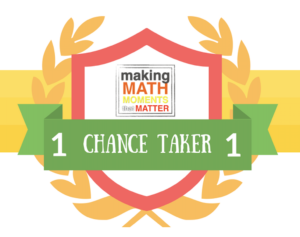Be a chance taker. What does this mean in math class?
For me, this means putting into practice what I know from research and what I believe about how humans learn math. In many areas of life, this seems like not much of a risk. We learn things all the time that make our lives better. We try new ways of organizing or day and our belongings. We learn from our experiences with others. We search the internet for solutions to our everyday problems. We take what we learn and we put it all into daily practice, making small (or large) tweaks as we go until we find what works well for us. Of course there are things we take big chances on. Starting a business. Approaching someone you would like to be friends or business partners with. Presenting an out-of-the-box idea to your boss. Sky diving.
While I believe in taking risks as a teacher and as a learner, I have found it difficult to make permanent changes in my teaching practices over the years. I believe completely that traditional methods of teaching math are not effective. I have seen this in action for myself and have had many discussions with students, parents, colleagues, and random people at social gatherings. What I find over and over again is that putting my beliefs into practice in my classroom invariably results in doubting myself and the effectiveness of non-traditional methods. This could happen after being confronted by a parent about a student’s scores and progress or after conversations with administrators and colleagues or even after the managing of all of the things in math class gets overwhelming. When the going gets tough, I tend to revert to what’s comfortable. You know, the way I was taught. Seemed to work for me, right?
The short answer is not really. I’ll be the first to tell you that I loved math in school because I was good at memorizing and following rules and procedures. {Any other first-born rule followers out there?} When I began teaching math at the middle school level, I also began discovering all the reasons why my beloved rules and algorithms worked. The problem was that my students weren’t making those same discoveries. I knew there had to be a better way.
And so, I tried new things. I took chances. I saw some positive results. Still, I wasn’t convinced that I was really on a good path and I felt alone in my beliefs. Nobody else around me was departing from the traditional. Then I discovered Jo Boaler (of YouCubed.org) and Dan Meyer (of dy/dan). Their ideas let me know that my ideas weren’t so crazy. In fact, my ideas and discoveries were right on track. The problem that remained for me was that I didn’t really know where to begin or what this new classroom structure could look like.
And now, here I am in this Making Math Moments Workshop. I am feeling validated in my beliefs about mathematics teaching and learning and I am finally getting to see what it actually looks like. I am also getting some direct instruction in how to make it happen in my own classroom. By the end of this course, I know I will feel more confident about taking chances with my teaching and I will have the skills to create lessons that engage students and spark curiosity about mathematics.
One of the tasks I was asked to complete during this first module was to reflect on a math moment in my life that mattered to me. A math memory, if you will, either good or bad. The one that sticks out to me the most comes from the third grade. My teacher had written several multiplication problems on the chalkboard and asked us to copy and complete them. There was the promise of a sticker to the fastest finishers. I knew I would be the first to complete my list of problems. Multiplication was my jam and I had the fine motor skills to write quickly, too. When I took my paper to the teacher’s desk for my sticker, I was shocked to be sent away. Why wouldn’t she accept my work? I knew all the answers were correct. Turns out, in my haste to be first, I had neglected to number the problems on my paper as they were numbered on the board. My paper wasn’t complete and I was sent back to my seat to add these details.
At the time, I was embarrassed. Now, it makes me sad that my work was not judged on my knowledge of multiplication. It also bothers me that speed was a factor. While I relished the competition then, now I know that speed doesn’t determine quality of thought or depth of knowledge.
Another task for the week was to express three things I want my students to take away from their time in my math class. Of course, one of the ones I shared was that speed isn’t important. It’s the deep thinking, pattern finding, and connection making that really matter. I also want my students to remember that being good at math requires effort, time, and practice just like any other skill. You don’t become a star soccer player by not playing soccer, right? My last thought is that there is no way they can avoid being a “math person.” {Check out my post on using math daily.}
A few big takeaways from my experience in Module 1:
- It is my responsibility to make sure my students are doing the lion’s share of the thinking. This means I have to put them in situations that are unfamiliar to them and allow them to explore and share ideas.
- Predictions, and improving predictions, should be the focus of problem solving as opposed to “What’s the answer?”
- Extend conceptual understanding by presenting questions related to the original task once that task has been solved.
- Sense-making matters and is facilitated by the careful structuring of idea sharing and modeling.
I know I am on the right path. I am still wondering, though, how to make sure my students come with me. It’s time for me to be a Chance Taker and create a classroom where students a willing to be Chance Takers, too!
Take a chance and check out the info and resources on the Making Math Moments That Matter website. I’d love to hear your thoughts!




Amazing! So happy to read that you are not only getting some big take aways from the online workshop but also that you’re now blogging, too! Bravo!!!
Can’t wait to read more!